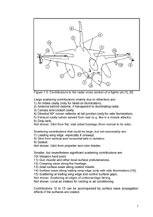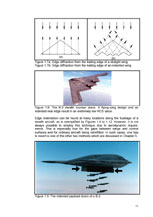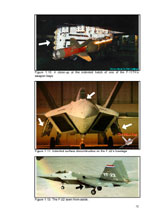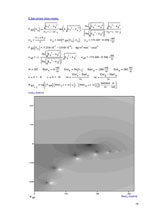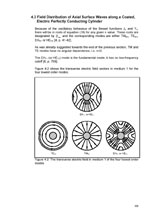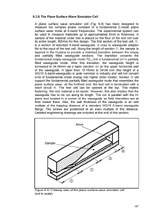Surface Waves
on Stealth Aircraft
Serge Y. Stroobandt
Copyright 1997–2016, licensed under Creative Commons BY-NC-SA
- Home
- Surface Waves & Stealth
Full title
The Characterization of Surface Waves
on Low-Observable Structures
being a Thesis submitted for the Degree of
Master of Science
in the University of Hull
by
Ing. Serge Yves Marcel Roland Stroobandt
August 1997
Highlights
Abstract
Edge diffracted waves resulting from surface discontinuities contribute significantly to the radar cross section of an object. Although this problem could be alleviated by altering the shape of the edge discontinuity, this is not always possible due to other mission requirements.
The backscatter from edge diffracted waves may also be reduced by converting the incoming radar waves into surface waves whose intensity is significantly reduced before reaching the surface discontinuity. This can be achieved by employing isotropic surface wave absorbing materials backed by a metal surface. However, for plane surface waves, the effectiveness of these materials is shown to be strongly polarization dependent.
This work suggests a new strategy which involves replacing the scattering surface by an electromagnetic soft surface. This would result in a complete elimination of the edge diffracted waves in the radar direction, independently of radar polarization.
Furthermore, a new measuring apparatus based on a partially filled rectangular waveguide has been developed for determining the attenuation constant and phase constant of plane surface waves propagating along metal-backed surface wave absorbing materials. Measurements are presented which validate this new measuring method.
Keywords
Radar Cross-Section (RCS) Management, Surface Waves, Radar Absorbing Materials, Electromagnetic Measurements
Contents
| Abstract | II |
| Acknowledgements | V |
| 1. Introduction | 1 |
| 1.1 Stealth Design | 1 |
| 1.2 Reducing the RCS Contribution of Edge Diffracted Waves | 10 |
| 1.3 Outline of this Text | 13 |
| 1.4 Conclusions | 14 |
| 1.5 References | 14 |
| 2. Hertz Potentials | 15 |
| 2.1 Introduction | 15 |
| 2.2 Hertz’s Wave Equation for Source Free Homogeneous Linear Isotropic Media | 17 |
| 2.3 Hertz’s Wave Equation in Orthogonal Curvilinear Coordinate Systems with Two Arbitrary Scale Factors | 18 |
| 2.4 Hertz’s Wave Equation in a Cartesian Coordinate System | 19 |
| 2.5 Hertz’s Wave Equation for a 2D-Uniform Guiding Structure | 20 |
| 2.6 Hertz’s Wave Equation in a Circular Cylindrical Coordinate System | 22 |
| 2.7 Conclusions | 25 |
| 2.8 References | 25 |
| 3. Plane Surface Waves Along Plane Layers of Isotropic Media | 26 |
| 3.1 Definition | 26 |
| 3.2 Plane Surface Waves and the Brewster Angle Phenomenon | 27 |
| 3.3 Plane Surface Waves, Total Reflection and Leaky Waves | 28 |
| 3.4 Plane Surface Waves along a Coated, Electric Perfectly Conducting Plane | 30 |
| 3.5 Plane Surface Waves along a Planar Three-Layer Structure | 79 |
| 3.6 Plane Surface Waves along the Plane Interface of Two Half Spaces | 91 |
| 3.7 Appendix A: The Phase Velocity of an Inhomogeneous Wave in a Loss Free Medium | 95 |
| 3.8 Appendix B: Proof of \(-\text{j}\sqrt{x} = \sqrt{-x}\) | 96 |
| 3.9 Conclusions | 97 |
| 3.10 References | 98 |
| 4. Axial Surface Waves in Isotropic Media | 99 |
| 4.1 Definition | 99 |
| 4.2 Axial Surface Waves along a Coated, Electric Perfectly Conducting Cylinder | 100 |
| 4.3 Field Distribution of Axial Surface Waves along a Coated, Electric Perfectly Conducting Cylinder | 105 |
| 4.4 Conclusions | 107 |
| 4.5 References | 107 |
| 5. RCS Management of Edge Diffracted Waves | 108 |
| 5.1 Introduction | 108 |
| 5.2 Converting the Incident Space Wave into Attenuated Surface Waves | 109 |
| 5.3 Soft Surfaces | 111 |
| 5.4 The Practical Realization of a Soft Surface | 113 |
| 5.5 Conclusions | 119 |
| 5.6 References | 120 |
| 6. Surface Wave Absorber Measurements | 121 |
| 6.1 Introduction | 121 |
| 6.2 A Historical Overview of Surface Wave Measurement Techniques | 122 |
| 6.3 A Plane Surface Wave Simulator Cell Based on a Partially Filled Rectangular Waveguide | 126 |
| 6.4 Conclusions | 158 |
| 6.5 References | 158 |
| 7. Conclusions | 159 |
Download the whole masterthesis in one file (10 MB PDF).
Publications
 S. Y. M. R. Stroobandt and F. C. Smith, “Method for measuring the attenuation and phase constants of a surface wave propagating along an infinite plane,” Electronics Letters, 33(20):1685–1686, September 1997
S. Y. M. R. Stroobandt and F. C. Smith, “Method for measuring the attenuation and phase constants of a surface wave propagating along an infinite plane,” Electronics Letters, 33(20):1685–1686, September 1997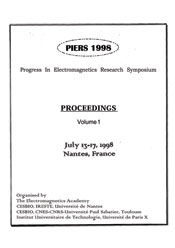 F. C. Smith and S. Y. M. R. Stroobandt, “The design principles and measurement of surface wave absorbing materials,” Progress in Electromagnetics Research Symposium (PIERS) Proceedings, Volume 1, page 369, July 1998
F. C. Smith and S. Y. M. R. Stroobandt, “The design principles and measurement of surface wave absorbing materials,” Progress in Electromagnetics Research Symposium (PIERS) Proceedings, Volume 1, page 369, July 1998

This work is licensed under a Creative Commons Attribution‑NonCommercial‑ShareAlike 4.0 International License.
Other licensing available on request.

Unless otherwise stated, all originally authored software on this site is licensed under the terms of GNU GPL version 3.
This static web site has no backend database.
Hence, no personal data is collected and GDPR compliance is met.
Moreover, this domain does not set any first party cookies.
All Google ads shown on this web site are, irrespective of your location,
restricted in data processing to meet compliance with the CCPA and GDPR.
However, Google AdSense may set third party cookies for traffic analysis and
use JavaScript to obtain a unique set of browser data.
Your browser can be configured to block third party cookies.
Furthermore, installing an ad blocker like EFF's Privacy Badger
will block the JavaScript of ads.
Google's ad policies can be found here.
transcoded by
 .
.

